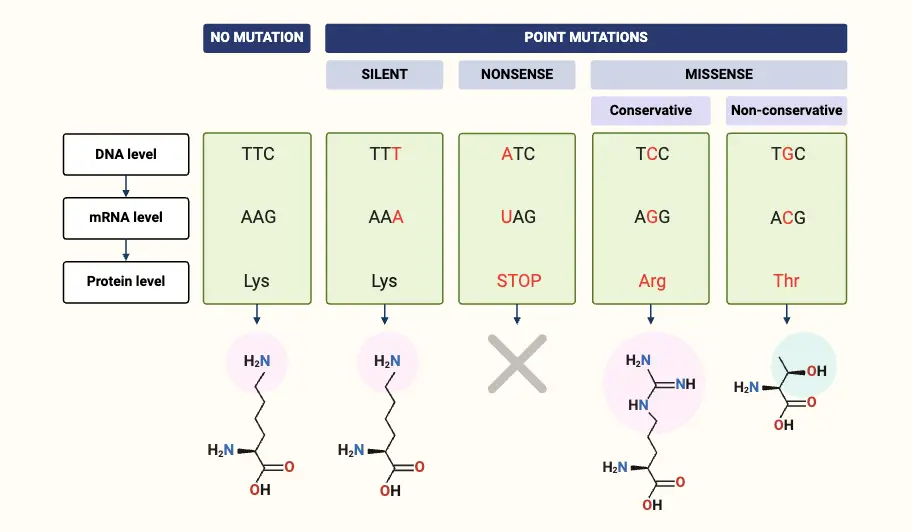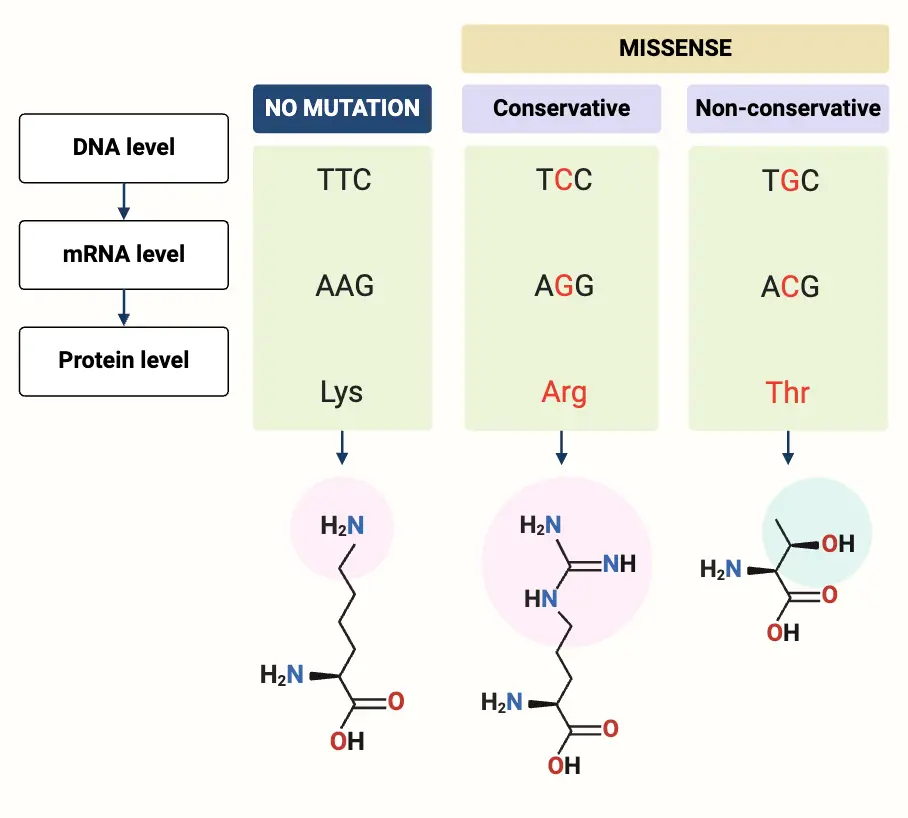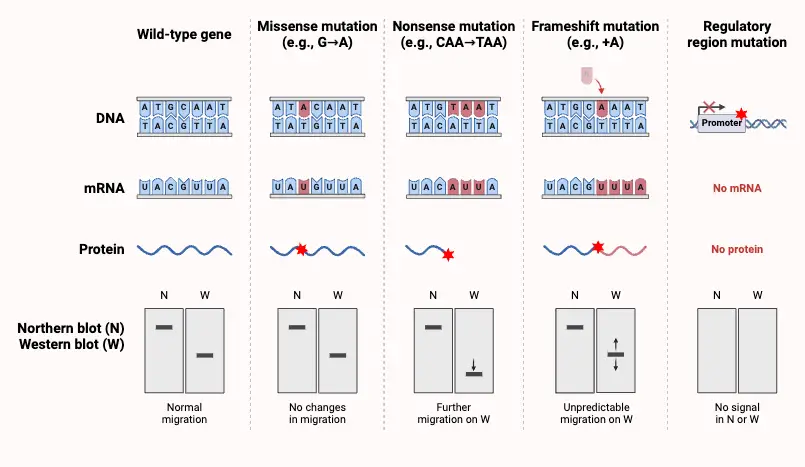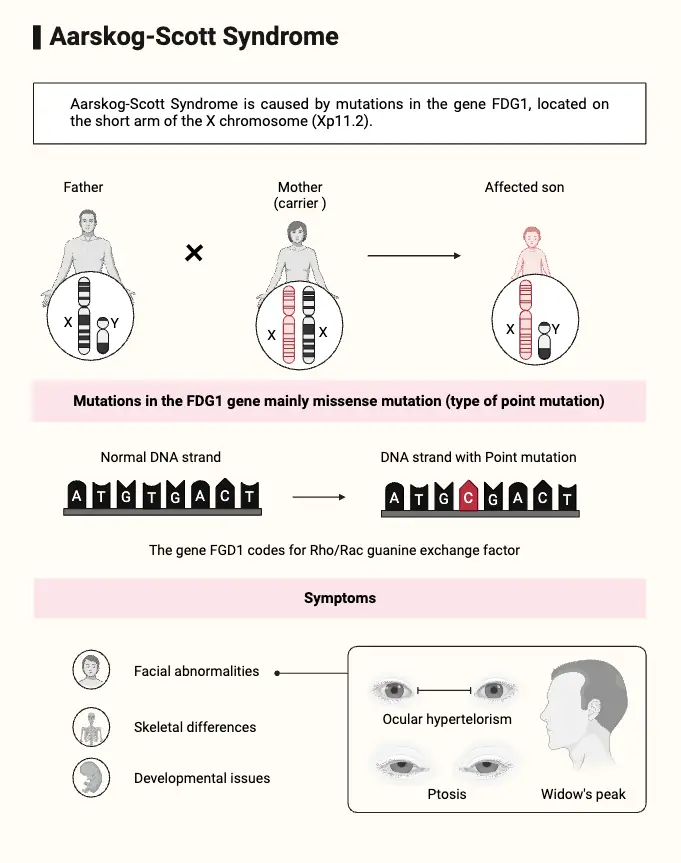What is Missense Mutation?
- A missense mutation is a specific type of point mutation characterized by the replacement of a single nucleotide base in the DNA sequence. This change results in the incorporation of a different amino acid into the protein during translation, altering the protein’s primary structure.
- In the process of protein synthesis, the genetic code is transcribed into mRNA, which is then translated into a protein sequence. A missense mutation introduces a change in one of these codons, which specifies a different amino acid than originally intended. Therefore, the resulting protein may have an altered amino acid sequence compared to the normal protein.
- The impact of a missense mutation on the protein function can vary widely. Sometimes, the mutation occurs in a region of the protein where the change has minimal effects, and the protein remains functional. In other instances, the altered amino acid can significantly affect the protein’s structure and function, leading to various diseases.
- The severity of the outcome associated with a missense mutation depends on the specific amino acid change and its location within the protein. For instance, a mutation may disrupt an active site or a critical structural domain of the protein.
- Missense mutations are classified as nonsynonymous substitutions because they result in a change to the protein sequence. In contrast, a silent mutation results in no change to the amino acid sequence, even though there is a nucleotide alteration.
- Notable examples of diseases caused by missense mutations include sickle cell anemia, where a single nucleotide change leads to the substitution of glutamic acid with valine in hemoglobin. This alteration causes the hemoglobin molecules to aggregate, leading to the characteristic sickling of red blood cells.
- Other diseases associated with missense mutations include Amyotrophic Lateral Sclerosis (ALS), where specific mutations lead to dysfunctional proteins involved in motor neuron health, and Epidermolysis Bullosa, a condition caused by mutations affecting skin integrity.
- Therefore, missense mutations play a crucial role in the study of genetic disorders, protein function, and the development of targeted therapies. Understanding the specific effects of these mutations helps in diagnosing and devising treatments for various genetic conditions.

Definition of Missense Mutation
A missense mutation is a type of point mutation in which a single nucleotide change results in the substitution of one amino acid for another in the protein sequence, potentially altering the protein’s function.

Types of Missense Mutation
There are two Types of Missense Mutation;
- Conservative Missense Mutation
- Definition: In a conservative missense mutation, the amino acid substitution results in an amino acid that is similar in chemical properties and function to the original amino acid.
- Impact: The new amino acid, while different, retains similar functional characteristics as the one it replaces. This often leads to minimal changes in protein function.
- Effect on Function: The functional impact of a conservative missense mutation may be minor, potentially leading to only slight alterations in protein activity. However, in certain contexts, this slight change could be advantageous.
- Biological Relevance: Such mutations might not significantly disrupt the protein’s overall function or the organism’s fitness, and could even be beneficial if they help in regulating protein function or adapting to new environmental conditions.
- Non-Conservative Missense Mutation
- Definition: A non-conservative missense mutation introduces an amino acid with different chemical properties compared to the original. For example, it might replace a polar amino acid with a non-polar one.
- Impact: This type of mutation often leads to substantial changes in the protein’s structure and function.
- Effect on Protein Structure: The alteration affects the primary structure by changing the amino acid sequence. This can disrupt secondary structures such as alpha helices and beta sheets, which are crucial for the protein’s tertiary and quaternary structures.
- Biological Relevance: Non-conservative mutations can significantly affect the protein’s interactions with other molecules and its ability to form or maintain its intended structure. This can lead to loss of function, or potentially result in a novel protein function. In some cases, this might disrupt entire biochemical pathways or create new functionalities.

Causes of Missense Mutation
Missense mutations are alterations in the DNA sequence that result in the substitution of one amino acid for another in the protein product. These mutations can arise from various mechanisms, both spontaneous and induced.
- Spontaneous Mutations:
- DNA Replication Errors: During DNA replication, errors can occur that lead to point mutations. A single nucleotide change at a specific location can cause a missense mutation. These errors can result from misincorporation of nucleotides or failure in proofreading mechanisms.
- DNA Processing: Besides replication, mutations can also arise during other DNA processing events, such as repair and recombination. These spontaneous mutations can lead to point mutations if they alter nucleotide sequences.
- Induced Mutations:
- Physical Agents: External physical agents such as X-rays and ultraviolet (UV) radiation can induce mutations. UV radiation, for example, can cause thymine dimers that disrupt normal DNA replication and repair processes, potentially leading to missense mutations if the repair is inaccurate.
- Chemical Agents: Reactive oxygen species (ROS) and other chemical mutagens can cause damage to DNA. ROS, generated as byproducts of cellular metabolism, can oxidize nucleotides, leading to mispairing during DNA replication. Additionally, chemical compounds like certain drugs and environmental pollutants can interact with DNA, causing nucleotide substitutions.
- Effects of Mutagens:
- Ionization of Molecules: Physical mutagens like X-rays cause ionization of DNA molecules, which can lead to structural changes in the DNA helix. These changes can result in nucleotide substitutions if the damage is not properly repaired.
- Chemical Modification: Chemical mutagens can modify nucleotides, leading to incorrect base pairing during DNA replication. This mispairing can result in a missense mutation if the altered nucleotide is incorporated into the DNA sequence.
- Nuclease Activity:
- Digestion of DNA: During replication or repair processes, nucleases can digest portions of the DNA sequence. If the sequence is incorrectly reconstituted, it can lead to nucleotide substitutions that manifest as missense mutations.
Examples of Missense Mutation
- Sickle Cell Anemia
- Mutation Details: Sickle cell anemia is a well-studied example of a missense mutation. It is caused by a single nucleotide substitution in the β-globin gene of hemoglobin, where glutamic acid (GAG) is replaced by valine (GTG).
- Effects: This non-conservative missense mutation alters the hemoglobin’s structure, leading to the formation of elongated, sickle-shaped red blood cells. These abnormal cells obstruct blood flow, causing pain, increased infection risk, and reduced lifespan of red blood cells.
- Biological Implications: While the mutation leads to significant health issues, it also provides a partial protective effect against malaria, as the sickle-shaped cells are less hospitable to the malaria parasite.
- Cystic Fibrosis
- Mutation Details: Cystic fibrosis is associated with missense mutations in the CFTR gene, which encodes the cystic fibrosis transmembrane conductance regulator protein.
- Effects: Missense mutations in the CFTR gene can disrupt the protein’s function, leading to thick mucus production and subsequent respiratory and digestive problems. These mutations vary in severity and impact on protein function.
- Li-Fraumeni Syndrome
- Mutation Details: Li-Fraumeni syndrome is caused by missense mutations in the TP53 gene, which encodes the p53 tumor suppressor protein.
- Effects: The TP53 missense mutation leads to a dysfunctional p53 protein that cannot effectively regulate cell division and suppress tumor growth. This results in an increased risk of developing various types of cancer.
- Beta-Thalassemia
- Mutation Details: Beta-thalassemia can be caused by missense mutations in the β-globin gene, affecting hemoglobin production.
- Effects: These mutations result in a reduced production of beta-globin chains, leading to imbalanced hemoglobin levels and anemia. The severity depends on the specific nature of the missense mutation.
- Epidermolysis Bullosa
- Mutation Details: Epidermolysis bullosa is often linked to missense mutations in genes such as COL7A1, which encodes type VII collagen.
- Effects: The mutations lead to defective collagen proteins, causing fragile skin that blisters and tears easily. This genetic disorder highlights how missense mutations can impact structural proteins essential for tissue integrity.
- Marfan Syndrome
- Mutation Details: Marfan syndrome is caused by missense mutations in the FBN1 gene, which encodes fibrillin-1.
- Effects: These mutations lead to defective connective tissue, resulting in symptoms such as long limbs, cardiovascular abnormalities, and eye problems. The missense mutations alter the structure and function of fibrillin-1.
- Hemophilia
- Mutation Details: Hemophilia can arise from missense mutations in genes like F8 or F9, which are critical for blood clotting.
- Effects: These mutations affect clotting factor proteins, leading to impaired blood clotting and increased bleeding risk. The specific symptoms and severity vary based on the mutation.
- Achondroplasia
- Mutation Details: Achondroplasia is a form of dwarfism caused by a missense mutation in the FGFR3 gene.
- Effects: The mutation leads to abnormal cartilage formation and bone growth, resulting in short stature and skeletal abnormalities.
- Huntington’s Disease
- Mutation Details: Huntington’s disease involves missense mutations in the HTT gene, although it is more commonly associated with a CAG repeat expansion. However, missense mutations also contribute to the disease’s pathology.
- Effects: The mutations result in the production of a mutated huntingtin protein, which leads to neurodegeneration and progressive motor dysfunction.
- Tay-Sachs Disease
- Mutation Details: Tay-Sachs disease can result from missense mutations in the HEXA gene, which encodes a hexosaminidase A enzyme.
- Effects: The enzyme deficiency leads to the accumulation of GM2 gangliosides in nerve cells, causing severe neurological deterioration.

How Do Missense Mutations Affect an Organism?
- Disease Pathogenesis: Missense mutations can play a critical role in the development of various diseases. For instance, mutations altering specific amino acids in proteins can disrupt normal cellular functions, leading to pathological conditions. Understanding these mutations aids in diagnosing and managing related diseases effectively.
- Genetic Disorder Treatment: Missense mutations are sometimes induced intentionally in genetic research to explore potential therapies. By introducing specific missense mutations, researchers can study their effects and develop strategies for treating or preventing genetic disorders through molecular therapy.
- Cancer Targeting: In oncology, induced missense mutations are employed to target cancer cells. By manipulating the genetic code to introduce specific mutations, researchers can disrupt the function of proteins essential for cancer cell survival, thus aiding in the development of targeted cancer treatments.
- Adaptation and Survival: Missense mutations can confer advantages in challenging environments. Such mutations may alter protein functions in a way that enhances an organism’s ability to survive and adapt to environmental stressors, contributing to evolutionary fitness.
- Crop Improvement: In agricultural biotechnology, missense mutations are utilized in mutation breeding to enhance crop traits. By inducing specific mutations, scientists can improve attributes such as disease resistance, yield, and nutritional value, leading to more robust and productive crop varieties.
- Protein Stability and Interaction: Studying missense mutations helps in understanding protein stability and interactions. These mutations can affect how proteins fold and interact with other molecules, providing insights into their functional characteristics and stability in various biological contexts.

Applications of Missense Mutation
- Disease Research and Pathogenesis
- Application: Missense mutations can provide insights into the genetic basis of various diseases. By studying how these mutations alter protein function, researchers can understand disease mechanisms and identify potential targets for therapeutic interventions.
- Example: Research on missense mutations in the CFTR gene has elucidated the pathogenesis of cystic fibrosis, leading to better diagnostic and treatment strategies.
- Molecular Therapy
- Application: Induced missense mutations can be employed in molecular therapy to correct genetic disorders. By introducing specific mutations, scientists can potentially restore or alter protein functions to mitigate disease symptoms.
- Example: Gene editing techniques, such as CRISPR/Cas9, can be used to introduce missense mutations to correct dysfunctional proteins in genetic diseases.
- Cancer Treatment
- Application: Missense mutations can be used strategically to target cancer cells. Inducing specific missense mutations in cancer cell proteins can disrupt their function, leading to cell death or reduced proliferation.
- Example: Research is ongoing into using missense mutations to modify tumor suppressor proteins or oncogenes to enhance cancer therapy.
- Agricultural Improvement
- Application: In agriculture, missense mutations have been utilized in mutation breeding to develop crops with desirable traits. By inducing these mutations, researchers can enhance crop yield, resistance to diseases, or environmental adaptability.
- Example: Mutation breeding has been used to create crop varieties with improved resistance to pests or environmental stressors.
- Protein Function and Stability
- Application: Missense mutations are valuable in studying protein stability, interactions, and active sites. By introducing specific mutations, scientists can assess how changes affect protein structure and function, providing insights into protein mechanics and stability.
- Example: Laboratory experiments use missense mutations to analyze the effects on enzyme activity or protein-protein interactions, which can be crucial for understanding biochemical pathways.
- Evolutionary Studies
- Application: Missense mutations can be used to study evolutionary processes and adaptations. By examining how specific mutations influence protein function, researchers can gain insights into evolutionary changes and natural selection mechanisms.
- Example: Comparative studies of missense mutations across species can reveal how proteins have evolved to meet different environmental challenges.
- Drug Development
- Application: Missense mutations are instrumental in drug development by providing targets for designing new therapeutics. Understanding how mutations affect protein function can help in creating drugs that specifically target mutant proteins.
- Example: Targeted therapies for diseases like cystic fibrosis and certain cancers are designed based on the knowledge of missense mutations affecting protein function.
- Diagnostic Tools
- Application: Identifying missense mutations in patients can aid in diagnosis and prognosis of genetic disorders. Genetic testing can detect these mutations and provide information on disease risk and management.
- Example: Genetic screening for missense mutations in BRCA1 and BRCA2 genes helps assess breast cancer risk and guide preventive measures.
- Functional Genomics
- Application: Missense mutations are used in functional genomics to understand gene function and regulation. By analyzing how mutations affect gene expression and protein function, researchers can elucidate gene roles and regulatory mechanisms.
- Example: Functional studies of missense mutations in model organisms help determine gene functions and interactions within cellular pathways.
- Synthetic Biology
- Application: In synthetic biology, missense mutations are employed to engineer proteins with novel functions. By introducing specific mutations, scientists can create proteins with enhanced or altered properties for various applications.
- Example: Engineering enzymes with altered catalytic activities through missense mutations can lead to new industrial or therapeutic applications.
Difference between Missense mutation and Nonsense mutation
- Definition
- Missense Mutation: This type of point mutation involves the substitution of one nucleotide for another in the DNA sequence, leading to the incorporation of a different amino acid into the protein. This alteration in the amino acid sequence can affect protein function.
- Nonsense Mutation: A point mutation where one nucleotide is replaced by another, resulting in the creation of a stop codon (UAG, UAA, or UGA) within the coding sequence. This premature stop codon halts protein synthesis prematurely.
- Effect on Codon
- Missense Mutation: Does not create a stop codon. Instead, it results in a codon that codes for a different amino acid, altering the protein’s primary structure.
- Nonsense Mutation: Always results in the formation of a stop codon, which terminates translation, leading to a truncated protein.
- Impact on Protein
- Missense Mutation: The resulting protein may retain partial functionality, become nonfunctional, or acquire a new function, depending on the nature and location of the amino acid change.
- Nonsense Mutation: Typically results in a nonfunctional protein due to the premature truncation, as the protein synthesis is halted before its completion.
- Protein Sequence
- Missense Mutation: Leads to an altered amino acid sequence within the protein. This can potentially impact the protein’s function or stability but does not always lead to a loss of function.
- Nonsense Mutation: Results in a shortened amino acid sequence because the translation process stops early, creating a truncated protein that is often nonfunctional.
- Examples
- Missense Mutation:
- Sickle Cell Anemia: Caused by a missense mutation in the β-globin gene where glutamic acid is replaced by valine, affecting hemoglobin function.
- Amyotrophic Lateral Sclerosis (ALS): Some forms involve missense mutations in the superoxide dismutase (SOD) gene, impacting its enzymatic activity.
- Nonsense Mutation:
- Dravet Syndrome: A severe form of epilepsy caused by a nonsense mutation in the SCN1A gene, leading to a truncated sodium channel protein.
- Missense Mutation:
- Biological Consequences
- Missense Mutation: Can result in varying outcomes, from benign changes to severe dysfunctions, depending on how the altered amino acid affects protein structure and function.
- Nonsense Mutation: Generally leads to severe consequences due to the production of a truncated protein, which often cannot perform its normal biological functions.
Facts
- Did you know that missense mutations occur when a single nucleotide substitution in the DNA sequence results in the incorporation of a different amino acid into the protein sequence?
- Have you heard that missense mutations can lead to a wide range of effects on protein function, from minimal changes to complete loss of function, depending on the nature of the amino acid substitution?
- Are you aware that missense mutations can be either conservative, where the new amino acid is similar in properties to the original, or non-conservative, where the new amino acid is chemically distinct?
- Can you believe that missense mutations are implicated in various genetic diseases, such as sickle cell anemia and cystic fibrosis, due to their impact on protein structure and function?
- Did you know that the severity of a genetic disease caused by a missense mutation can vary based on the location of the mutation within the gene and the role of the affected protein?
- Have you heard that some missense mutations can lead to a gain of new functions or altered activities in proteins, which can have both beneficial and detrimental effects on the organism?
- Are you aware that missense mutations are used in research to study protein function, protein interactions, and the effects of specific amino acid changes on biological processes?
- Can you believe that missense mutations can sometimes be used in biotechnology to engineer proteins with new or enhanced functions for industrial and therapeutic applications?
- Did you know that missense mutations can be part of natural evolutionary processes, where beneficial mutations may enhance an organism’s adaptability to its environment?
- Have you heard that understanding missense mutations is crucial for developing personalized medicine approaches, as they can help in diagnosing genetic disorders and tailoring treatments based on individual genetic profiles?
Reference
- Zhou X, Iversen ES Jr, Parmigiani G. Classification of Missense Mutations of Disease Genes. J Am Stat Assoc. 2005;100(469):51-60. doi: 10.1198/016214504000001817. PMID: 18418466; PMCID: PMC2311507.
- Kasper, Carol & Buzin, Carolyn. GENETICS OF HEMOPHILIA A AND B An introduction for clinicians, 2007.
- https://biologydictionary.net/missense-mutation/
- https://en.wikipedia.org/wiki/Missense_mutation
- https://www.biologyonline.com/dictionary/missense-mutation
- https://www.technologynetworks.com/genomics/articles/missense-nonsense-and-frameshift-mutations-a-genetic-guide-329274
- https://theory.labster.com/point-mutation/
- https://www.cancer.gov/publications/dictionaries/cancer-terms/def/missense-mutation
- Text Highlighting: Select any text in the post content to highlight it
- Text Annotation: Select text and add comments with annotations
- Comment Management: Edit or delete your own comments
- Highlight Management: Remove your own highlights
How to use: Simply select any text in the post content above, and you'll see annotation options. Login here or create an account to get started.